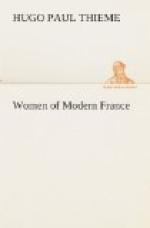The first of the royal French women to whom modern woman owes a great and clearly defined debt was Anne of Brittany, wife of Louis XII. and the personification of all that is good and virtuous. To her belongs the honor of having taken the first step toward the social emancipation of French women; she was the first to give to woman an important place at court. This precedent she established by requesting her state officials and the foreign ambassadors to bring their wives and daughters when they paid their respects to her. To the ladies themselves, she sent a “royal command,” bidding them leave their gloomy feudal abodes and repair to the court of their sovereign.
Anne may be said to belong to the transition period—that period in which the condition of slavery and obscurity which fettered the women of the Middle Ages gave place to almost untrammelled liberty. The queen held a separate court in great state, at Blois and Des Tournelles, and here elegance, even magnificence, of dress was required of her ladies. At first, this unprecedented demand caused discontent among men, who at that time far surpassed women in elaborateness of costume and had, consequently, been accustomed to the use of their surplus wealth for their own purposes. Under Anne’s influence, court life underwent a complete transformation; her receptions, which were characterized by royal splendor, became the centre of attraction.
Anne of Brittany, the last queen of France of the Middle Ages and the first of the modern period, was a model of virtuous conduct, conjugal fidelity, and charity. Having complete control over her own immense wealth, she used it largely for beneficent purposes; to her encouragement much of the progress of art and literature in France was due. Hers was an example that many of the later queens endeavored to follow, but it cannot be said that they ever exerted a like influence or exhibited an equal power of initiation and self-assertion.
The first royal woman to become a power in politics in the period that we are considering was Louise of Savoy, mother of Francis I., a type of the voluptuous and licentious female of the sixteenth century. Her pernicious activity first manifested itself when, having conceived a violent passion for Charles of Bourbon, she set her heart upon marrying him, and commenced intrigues and plots which were all the more dangerous because of her almost absolute control over her son, the King.




